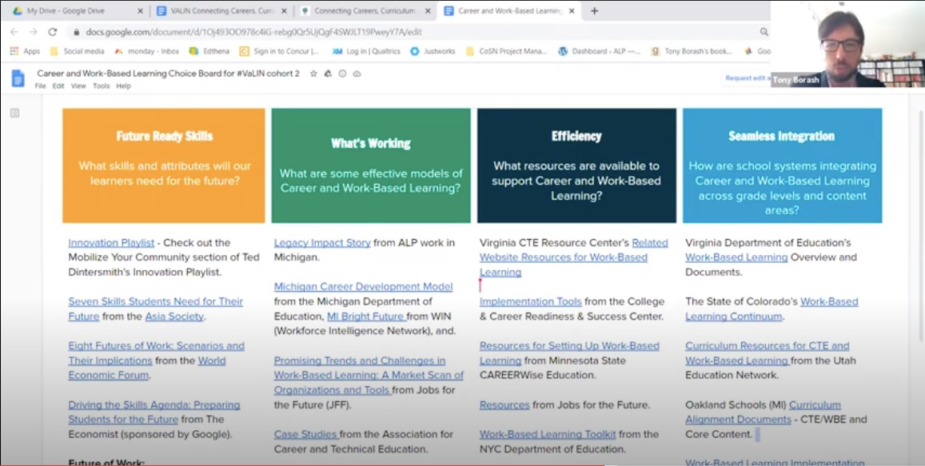Across the Commonwealth, school districts seeking to make learning experiences more authentic and purpose-driven for their students are exploring the intersection between and among career preparation, curricular outcomes, and community engagement. To that end, several VaLIN Innovation Teams are designing and facilitating systems to define career pathways, establish high-interest academies, and/or expand community partnerships that facilitate student transfer of learning into a real-world context.
As an area of focus embedded in the Virtual VaLIN Summer Pathways, the Connecting Careers, Curriculum, and Community series intends to unite participants around these shared goals. During the launch on June 23, participants from Chesapeake, Nottoway, Isle of Wight, and Nelson shared some context for their driving questions:
- How might we create a continuous and consistent bridge between STEM education, core content areas, and CTE? Teresa Finch and the team at Isle of Wight highlighted this goal, paired with a desire to enhance equity and opportunity throughout the student experience. In particular, she is curious about how to ensure that STEM doesn’t become ‘separate’ but rather an integrated component of learning. They have a lot of PBL in the midst and in expansion and are toying with the idea of Genius Hour as a means of community problem-solving.
- What might be our next phase of programs for meeting community needs? Valarie Harris expanded on that goal, outlining Nottoway’s introduction of the 3Es: Expose, Explore, and Experience with regards to Connecting Careers, Curriculum and Community. At the elementary level, they want to expose the students to possible career opportunities. At the middle school level, students will explore career opportunities. Finally, at the high school level, they will have experiences with various careers. At the career-focused high school where she is the principal, they currently have 5 programs in place at the school, with the space for as many as 10. Her question: What’s next?
- What opportunities are there in our region for increased viability? On a related note, Ryan Yarzebinski and his team of Nelson County educators strive to grow and develop relationships in the surrounding community to impact student trajectory and outcomes, especially with regard to CTE. Historically, the district is strong in its agriculture / horticultural focus, as it is where work-based competencies are best aligned within their academy. That said, they have interest in expanding beyond this pathway.
Reviewing a resource bank of aligned content, the following particularly resonated with participants:
- Driving the skills agenda: Preparing students for the future || This article from The Economist explores the shifting skills demanded by employers because of more pervasive technology, the disappearance of traditional trades, and the world of work becoming more globalized, interconnected, and collaborative.
- STEAM Implementation & Action Guide for School Leadership || This resource based out of VaLIN Cohort 2 member district Henrico Public School lays out an action and implementation guide for school leadership teams making the programmatic shifts from acquiring knowledge and skills –> applying classroom practices –> actualizing and amplifying STEAM across schools.
- Promising Trends and Challenges in Work-Based Learning || Jobs for the Future reveals a number of promising trends in career exploration and work-based learning and explores possible solutions for continuing challenges.
- Possible Futures Curriculum || Jobs for the Future has also developed an interactive career exploration curriculum helping students in grades 6 through 10 explore STEM occupations, develop essential skills such as collaboration and communication, and learn how to positively contribute to their communities.
As a next step from our time together, participants ‘took the leap’ to venture into any one of many design challenges to promote infusion of community engagement into their career-focused innovation projects.
- Nottoway is looking to visit and learn more from Isle of Wight’s current program offerings.
- Isle of Wight is looking to expand its STEM program offerings to ALL students.
- Nelson is looking to expand program offerings beyond Agriculture focus. Looking at cybersecurity and 3D Drafting options.
The continuation of our discussion on Connecting Careers, Community, and Curriculum will take place on July 14th at 1:00 pm EST. We hope you will consider joining us and adding your voice and ideas to our conversation.
For additional resources, check out the conversation at this YouTube link, as well as the interactive agenda, resource collection, and Padlet workspace.
— Facilitators Craig Bennett and Tony Borash

